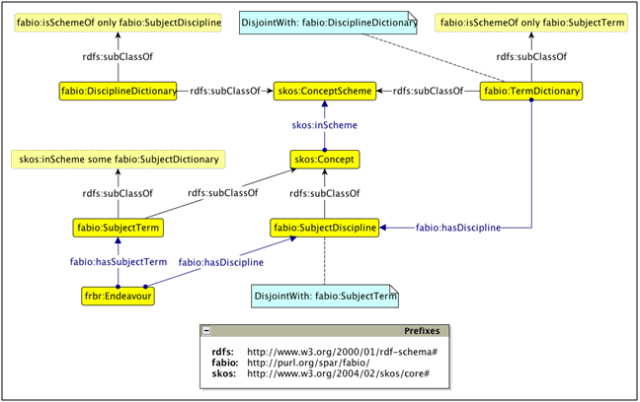One of the most important need for a publisher is to categorising each bibliographic entity it produces by adding free-text keywords and/or specific terms structured according to recognised classification systems and/or thesauri specific for certain academic disciplines. Academics have the same need when annotating bibliographic references.
SKOS, the Simple Knowledge Organization System [1], is an RDFS model to support the use of knowledge organization systems (KOS) such as thesauri, classification schemes, subject heading lists and taxonomies within the framework of the Semantic Web. The reception of this language has been particularly positive: a large number of well-known thesauri and classification systems, including the Medical Subject Headings (MeSH) and the Library of Congress Subject Headings (LCSH), have started to convert their respective specifications into SKOS documents. This makes SKOS the de facto standard for encoding controlled vocabularies for the Semantic Web, and it is in this role that we have employed it within FaBiO.
While, through FaBiO, the FRBR-aligned Bibliographic Ontology, the definition of keywords is possible using the PRISM property prism:keyword, terms from thesauri, structured vocabularies and classification systems are best described using SKOS. To facilitate this, FaBiO extends some classes and properties of SKOS as shown in the following Graffoo diagram.

The extensions to the common SKOS classes and relations implemented in FaBiO
As shown, any FRBR endeavour can be associated with one or more descriptive terms (fabio:hasSubjectTerm fabio:SubjectTerm, a sub-class of skos:Concept) found in a specific dictionary (fabio:TermDictionary, a sub-class of skos:ConceptScheme) that is relevant to one or more particular disciplines (fabio:hasDiscipline fabio:SubjectDiscipline, also a sub-class of skos:Concept) describing a field of knowledge or human activity such as Computer Science, Biology, Economics, Cookery or Swimming. These discipline names (fabio:SubjectDiscipline) are recorded within a discipline dictionary (fabio:DisciplineDictionary, also a sub-class of skos:ConceptScheme).
For example, “cell”, “mitochondrion” and “Cell Biology” are members (fabio:SubjectTerms) of the Cell Biology Term Dictionary, a particular fabio:TermDictionary. This Cell Biology Term Dictionary has a scientific subject discipline (fabio:hasSubjectDiscipline), revealed by its name, of “Cell Biology”. This subject discipline is a member of the class fabio:SubjectDiscipline, and is contained within a fabio:DisciplineDictionary entitled “Science Subject Dictionary”.
Of course, the granularity of application of such an information model is up to the user, since from the point of view of the cell biology specialist, “cell biology” is his subject discipline, whereas from the point of view of a librarian cataloguing books, “cell biology” might be a subject term.
The following RDF example (in Turtle) shows how these concepts can be used to enrich a bibliographic record:
@prefix skos: <http://www.w3.oeg/2004/02/skos/core#>
@prefix acm: <http://www.acm.org/class/1998/> .
@prefix dbpedia: <http://dbpedia.org/resource/> .
@prefix wiley: <http://onlinelibrary.wiley.com/doi/> .
:intertextual-semantics a fabio:ResearchPaper
; dcterms:title “Intertextual semantics: A semantics for information design”
; fabio:hasPortrayal wiley:10.1002/asi.21134/full
; prism:keywords “semantics of markup” , “semiotic application” , “xml”
; fabio:hasSubjectTerm acm:markup-languages , acm:semantics .
acm:markup-languages a fabio:SubjectTerm
; skos:prefLabel “Markup languages”
; skos:inScheme <http://www.acm.org/class/1998>
; skos:broader acm:document-preparation .
acm:semantics a fabio:SubjectTerm
; skos:prefLabel “Semantics”
; skos:inScheme <http://www.acm.org/class/1998>
; skos:broader acm:formal-definitions-and-theory .
<http://www.acm.org/class/1998> a fabio:TermDictionary
; skos:prefLabel “The 1998 ACM Computing Classification System”
; fabio:hasDiscipline dbpedia:Computer_science .
[1] Miles, A., Bechhofer, S. (2009). SKOS Simple Knowledge Organization System Reference. W3C Recommendation, 18 August 2009. World Wide Web Consortium. http://www.w3.org/TR/2009/REC-skos-reference-20090818/.

Pingback: Comparison of BIBO and FaBiO | JISC Open Citations
Pingback: Who says tags are not a controlled vocabulary? « Carmon Thomas
Pingback: JISC Open Citations Project – Final Project Blog Post | JISC Open Citations
Pingback: Comparison of BIBO and FaBiO | Semantic Publishing